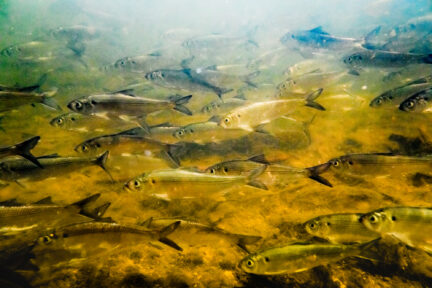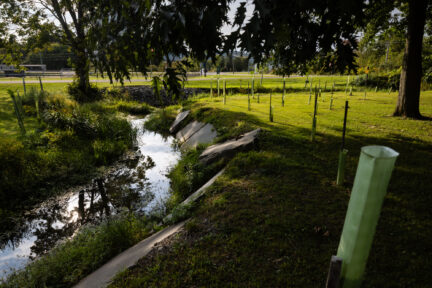Progress on oyster restoration in Maryland, Virginia
The National Oceanic and Atmospheric Administration (NOAA) Chesapeake Bay Office, along with the Chesapeake Bay Program (CBP), released reports today outlining the progress made by Maryland and Virginia in recent years to increase significant acreage of oyster reefs.
The National Oceanic and Atmospheric Administration (NOAA) Chesapeake Bay Office, along with the Chesapeake Bay Program (CBP), released reports today outlining the progress made by Maryland and Virginia in recent years to increase significant acreage of oyster reefs. These multiagency efforts support the outcome outlined in the Chesapeake Bay Watershed Agreement, which seeks to continually increase finfish and shellfish habitat and water quality benefits from restored oyster populations, as well as to restore native oyster habitat and populations in 10 tributaries by 2025 and ensure their protection.
Maryland Summary Update – This is the sixth annual update on large-scale oyster restoration efforts in the state, which describes work in Harris Creek, the Little Choptank River and the Tred Avon River. This summary of work, developed by the Maryland Oyster Restoration Interagency Workgroup, quantifies what was accomplished in the previous year, as well as cumulatively since work started in 2011:
- In 2016, the initial phase of Harris Creek restoration was completed on the final 165 acres of oyster reefs.
- A total of nearly 800 million oyster seed were planted in Harris Creek, the Little Choptank River and the Tred Avon River.
- A significant science and monitoring program is under way on and near restoration sites, including research to quantify the ecological and economic benefits of restored oyster reefs, and detailed monitoring to track reef health.
- The Maryland Oyster Advisory Commission is working on recommending the fourth and fifth tributaries.
Virginia Summary Update - This is the first year the three tributary-focused workgroups in Virginia that coordinate the planning and implementation for restoration in the Lafayette, Piankatank and Lynnhaven rivers have compiled a report to summarize their work:
- In the Lafayette River, the workgroup determined there are 70.5 acres that meet the definition of a restored reef, leaving 9.5 acres remaining to achieve the 80-acre restoration target.
- In the Piankatank, 25 acres of reefs have been constructed since work started in 2014; the Piankatank workgroup is working to set a specific restoration goal.
- In the Lynnhaven, 63 acres have already been restored. The workgroup is analyzing how much restorable bottom exists in order to set a restoration acreage goal.
- The Great Wicomico and lower York rivers have been preliminarily selected to be Virginia’s fourth and fifth tributaries for restoration.
Funding for these oyster restoration projects comes from federal, state and local governments as well as nonprofit partners - all working to support goals of the Chesapeake Bay Program.
Facts
The Oyster outcome in the Chesapeake Bay Watershed Agreement seeks to continually increase finfish and shellfish habitat and water quality benefits from restored oyster populations. It also looks to restore native oyster habitat and populations in 10 tributaries by 2025 and ensure their protection.
Currently, six Chesapeake Bay tributaries have been selected for oyster restoration: Harris Creek, the Little Choptank and Tred Avon rivers in Maryland, and the Lafayette, Lynnhaven and Piankatank rivers in Virginia. Each river is at a different level of progress that involves developing a tributary restoration plan, constructing and seeding reefs, and monitoring and evaluating restored reefs. The last phase of this process – reef monitoring and evaluation – will determine success in meeting this outcome.
Issues
Disease, historical overharvesting, degraded water quality and habitat loss have led to a severe drop in oyster populations over the last century. Excess nutrients in the water fuel the growth of algae blooms that create low-oxygen “dead zones” that hinder development of oyster larvae. Stress related to poor water quality can make oysters more susceptible to disease and impacts reproduction. Additionally, as a clean shell is a vital habitat for oysters, any sediment that covers has the potential to cause suffocation. As a result, oyster populations in the Chesapeake Bay are at a fraction of historic levels.
Importance
Oysters are ecologically valuable as filter-feeders that clean the waters of the Chesapeake Bay and its waterways by pumping water through their gills, trapping food particles, nutrients, suspended sediments and chemical contaminants. As oysters grow, larvae settle on shells of other oysters, forming layers that spread up and out. These reefs offer food and habitat to other animals. Oyster restoration at the tributary level aims to increase oyster populations to provide the ecosystem services that oyster reefs perform, including water quality improvements and habitat for aquatic critters.
Since the late nineteenth century, the oyster industry – including the catch, sale, shucking, packing and shipping of oysters – has contributed hundreds of millions of dollars to the region’s economy.
Quotes
“These updates highlight progress made by Chesapeake Bay oyster restoration partners toward the goal of restoring oysters in 10 tributaries by 2025. The collective impact of efforts by agencies, nonprofits, and academic partners in Maryland and Virginia--including science, planning, implementation, and monitoring--is significant.”
- Peyton Robertson, Director, NOAA Chesapeake Bay Office and Chair, Sustainable Fisheries Goal Implementation Team
"These reports are so much more than numbers on paper; they represent the great strides we've made with our partners— not just last year but since our journey began in 2011 —to help restore a sustainable oyster population in our Bay and provide all of the benefits that come along with healthy oyster reefs. The Interagency Oyster Restoration Program is a monumental undertaking, but the positive initial monitoring results we've received from restored sites give us hope that we will have the continued support to carry out this critical program. We are excited to resume and complete oyster restoration on 10 more acres in the Tred Avon River this spring."
- Colonel Ed Chamberlayne, Commander, U.S. Army Corps of Engineers Baltimore District
“Maryland is committed to oyster restoration in the Chesapeake Bay and its tributaries as part of the Chesapeake Bay Watershed Agreement. Oysters are critically important to our economy and environment."
- Mark Belton, Secretary, Maryland Department of Natural Resources
"Large scale oyster restoration provides a direct benefit for many of Virginia's valuable fisheries. It creates additional brood stock for nearby harvest areas, improves overall water quality, and creates critical habitat for many other ecologically and economically important species"
- Andrew Button, Oyster Replenishment Officer, Virginia Marine Resources Commission



